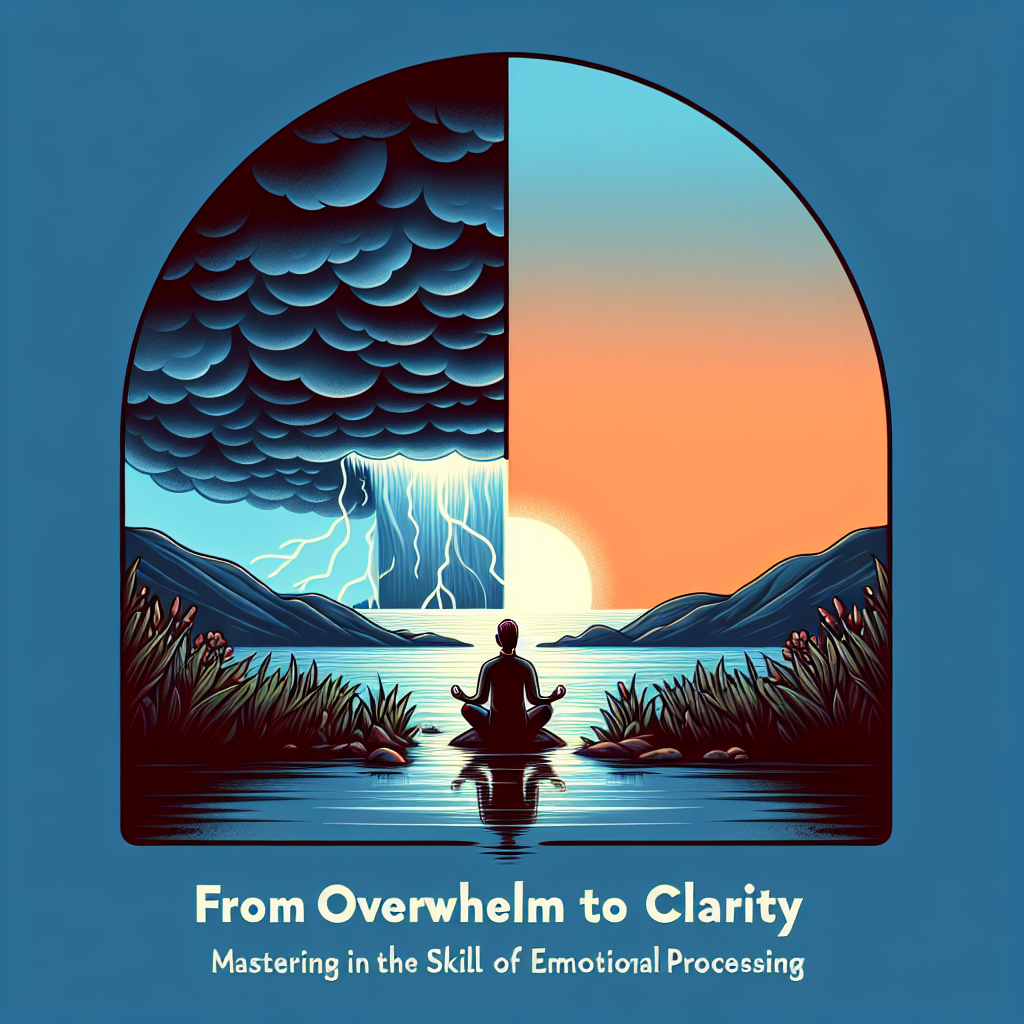
Introduction
In the chaos of modern life, emotional overwhelm can feel like a relentless tide, pulling us further from clarity and serenity. We’ve all experienced those moments—when emotions surge and blend, leaving us feeling disoriented and paralyzed. Yet, mastering the skill of emotional processing can empower us to navigate these turbulent waters with ease and grace. In this comprehensive guide, "From Overwhelm to Clarity: Mastering the Skill of Emotional Processing," we will explore the transformative power of emotional intelligence, practical methods for emotional processing, and inspiring real-world case studies to illustrate our journey toward clarity.
Understanding and managing our emotions can be the difference between thriving and merely surviving. Whether you’re a busy professional, a parent juggling countless responsibilities, or an individual navigating life’s ups and downs, developing this crucial skill is essential. Ready to transform your emotional landscape? Let’s dive in!
Understanding Emotional Processing
What is Emotional Processing?
At its core, emotional processing encompasses our ability to recognize, understand, and manage our emotions. It’s a skill that helps us interpret our feelings and respond to them effectively, leading us to a clearer state of mind.
Table 1: Emotional Processing vs. Emotional Suppression
| Aspect | Emotional Processing | Emotional Suppression |
|---|---|---|
| Recognition | Acknowledges feelings | Avoids or hides feelings |
| Response | Engages and reflects | Represses and ignores |
| Outcome | Clarity and growth | Anxiety and confusion |
Why is Emotional Processing Important?
Emotionally processed experiences can lead to profound insights and healthier relationships. People who master this skill often experience enhanced decision-making abilities, improved mental health, and increased resilience.
The Process of Emotional Processing
1. Acknowledge Your Emotions
The first step toward moving "From Overwhelm to Clarity" is acknowledgment. Instead of brushing emotions aside, confront them directly.
Strategy: Take a moment each day for self-reflection. Journaling can serve as a powerful tool for this acknowledgment. Write down your feelings without judgment, allowing yourself to feel fully.
2. Understand the Source
Next, investigate the origins of your emotions. Are they rooted in past experiences or current stressors?
Case Study: Sarah’s Journey to Insight
Sarah, a marketing manager, felt overwhelmed by anxiety during her team’s quarterly presentations. By journaling, she discovered that her fear stemmed from a childhood experience of public speaking. Acknowledging this connection helped her reclaim her confidence.
3. Let It Out
Expressing emotions is crucial for emotional processing. Bottling them up can lead to increased stress and overwhelming anxiety.
Strategy: Talk to someone you trust or engage in creative outlets. Painting, music, or even physical activity can provide catharsis and clarity.
4. Reframe and Release
Once you identify and process your emotions, it’s time to reframe them. Shift your perspective from victimization to empowerment.
Example: Instead of thinking, “I am anxious about this presentation,” try reframing it as, “This is an opportunity to share my vision.”
Table 2: Reframing Techniques
| Old Thought | Reframed Thought |
|---|---|
| I’m overwhelmed by tasks. | I have the chance to prioritize and organize. |
| I always fail in stressful situations. | Each failure is a lesson that brings me closer to success. |
Techniques for Mastering Emotional Processing
Mindfulness and Meditation
Mindfulness practices can significantly support emotional processing. Mindfulness encourages living in the present moment, allowing you to observe emotions without judgment. Meditation can soothe the mind, providing clarity and enabling you to better process emotions.
Therapy and Professional Help
Sometimes, professional guidance may be necessary. Cognitive Behavioral Therapy (CBT) or other therapeutic modalities can offer structured support for learning emotional processing skills.
Case Study: James and CBT
James felt persistent sadness after a recent loss. Enrolling in CBT helped him identify negative thought patterns tied to his grief. Through guided emotional processing, he discovered new ways to connect with his memories positively.
Emotional Check-In
Incorporate regular emotional check-ins into your routine. This can be as simple as asking yourself, “What am I feeling right now?” or rating your feelings on a scale of 1-10.
The Role of Emotional Intelligence
What is Emotional Intelligence?
Emotional Intelligence (EI) is the ability to recognize, understand, and manage our own emotions, as well as those of others. High EI contributes significantly to mastering emotional processing.
Table 3: The Five Components of EI
| Component | Description |
|---|---|
| Self-Awareness | Recognizing your emotions and their triggers |
| Self-Regulation | Managing emotions appropriately |
| Motivation | Utilizing emotions to achieve goals |
| Empathy | Understanding and relating to others’ emotions |
| Social Skills | Skillfully handling relationships |
Building Emotional Intelligence
To enhance your EI, practice empathy by actively listening to others and reflecting on their emotions. This interaction often leads to increased self-awareness and insight.
Creating a Personal Emotional Processing Plan
Step 1: Set Clear Intentions
Define what you want to achieve through emotional processing. Clarity in your intentions will guide your journey.
Step 2: Choose Your Techniques
Select methods that resonate with you. Whether it’s journaling, meditation, or therapy, find what fits your lifestyle.
Step 3: Monitor Your Progress
Regularly assess how effectively you are processing your emotions. Are you feeling clearer? Engage in self-reflection to celebrate milestones.
Step 4: Seek Support When Needed
If you find yourself stuck or overwhelmed, don’t hesitate to reach out for support, whether from friends, family, or professionals.
Inspirational Real-World Applications
Case Study: Emma’s Journey
Emma, a busy mother, often felt overwhelmed by her responsibilities. She began to implement emotional processing techniques—including mindfulness and journaling. Through this practice, she not only reclaimed her sense of calm but also became more attuned to her children’s emotional needs.
The Workplace Impact: Team Dynamics
In workplaces where emotional processing is prioritized, teams often perform better. A company adopted emotional intelligence training, leading to improved collaboration and reduced turnover rates.
The Community: Building Resilience
Communities focused on emotional processing have demonstrated enhanced resilience. By creating safe spaces for emotional expression, they empower individuals to share their experiences, fostering supportive cultures.
Conclusion
Transitioning "From Overwhelm to Clarity: Mastering the Skill of Emotional Processing" is a transformative journey. By embracing your emotions, understanding their roots, and engaging in effective processing techniques, you can achieve a sense of clarity that permeates every aspect of your life. Remember that mastering emotional processing is not merely about avoidance; it’s about engaging deeply, learning, and growing.
Here’s to your journey of emotional clarity—may it lead you to a richer, more fulfilling life!
FAQ Section
1. What is emotional processing, and why is it important?
Emotional processing is the ability to recognize, understand, and manage our emotions. It’s important because it fosters personal growth, improves mental health, and enhances decision-making.
2. How can I start processing my emotions?
Begin by acknowledging and journaling your feelings. You can also express emotions through creative outlets or seek support from friends or therapists.
3. What techniques can help with emotional processing?
Mindfulness, meditation, therapy (like CBT), emotional check-ins, and journaling are effective techniques for mastering emotional processing.
4. How can emotional intelligence enhance processing skills?
Emotional intelligence assists by increasing self-awareness and empathy, enabling you to understand your emotions and respond effectively to those of others.
5. Is it normal to struggle with emotional processing?
Yes, many people find emotional processing challenging. With practice and support, it becomes easier and can lead to significant personal development.
This comprehensive guide aims to provide not only unique insights into emotional processing but also practical methods for achieving clarity in the face of overwhelm. As you master these skills, you’ll likely find yourself navigating life’s challenges with resilience and confidence.

















